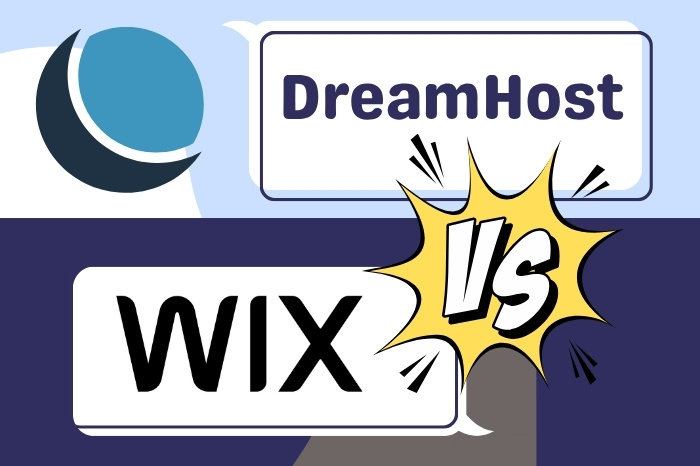Choosing between DreamHost and Squarespace can feel weirdly stressful.
Especially when you’re just trying to start a blog and the internet keeps yelling things like “bandwidth,” “servers,” and “just migrate later.”
(Spoiler: you do not want to “just migrate later.”)
I’ve used both DreamHost and Squarespace over the years — and while they’re both good platforms, they’re built for very different kinds of people and very different long-term goals.
Problem is, most comparison posts just throw a feature table and assume you already know what you need.
Beginner-me didn’t. And if you’re here, you probably don’t either yet.
So this post is the human version of DreamHost vs Squarespace: what it’s actually like to use each one, who they’re best for, and how to choose without accidentally boxing your future blog into a corner.
DreamHost vs Squarespace: Read This Before Comparing Anything
Let’s pause for a second — because this choice gets way easier once you look at it the right way.
DreamHost and Squarespace aren’t really competing with each other.
They’re solving two completely different problems.
Think of it like this:
- DreamHost is renting an apartment.
- Squarespace is booking a hotel room.
Both give you a place to stay.
Both can look great.
But the experience — and the expectations — are totally different.
With DreamHost, you’re getting the keys.
You choose the furniture (themes), install whatever you want (plugins), and decide how everything works. It takes a bit of setup, but once you’re in, it’s yours.
With Squarespace, everything is already set up.
The bed is made. The lighting is perfect. The towels match.
You just show up, add your content, and live your life.
Neither approach is “better.”
They’re just built for different personalities and goals.
So before we talk about pricing, speed, or features, ask yourself this:
Do I want control and long-term flexibility — or simplicity and zero setup?
If the idea of learning a few basics and growing your site over time sounds exciting (or at least acceptable), DreamHost will feel empowering.
If the idea of touching anything technical makes your brain quietly shut down, Squarespace will feel like a relief.
Once you’re clear on this, the rest of the comparison stops being overwhelming — and starts feeling obvious.
DreamHost: Best for Bloggers Who Want Control (Without Corporate Nonsense)

DreamHost is a traditional web host — the kind that gives you ownership over your site instead of locking you into a platform.
It’s been around since 1997 (which, in internet years, is basically ancient), and its whole thing has always been: you control your website, we handle the infrastructure.
If you’re building a blog with long-term plans — content growth, monetization, maybe even a shop later — this matters more than it sounds at the beginning.
What I personally like about DreamHost (after 5+ years of actually using it, not just promoting it):
- You own your site
WordPress, themes, plugins — you’re not limited to a closed system. - Pricing stays sane
No constant upsells, no surprise “gotcha” renewals. - Beginner-friendly once you’re in
The dashboard isn’t flashy, but it’s logical — and support actually explains things instead of sending you in circles. - Security + backups are handled
You don’t need to duct-tape plugins together just to feel safe. - Privacy is taken seriously
Which is surprisingly rare, and something I care about a lot.
That said, DreamHost is not a drag-and-drop builder.
You don’t click a template and magically have a website in 20 minutes.
You’ll need to learn a few basics (or follow a setup guide once and forget about it forever).
If that sounds terrifying, keep reading — Squarespace exists for a reason.
But if you want flexibility, scalability, and a blog that can grow without hitting invisible platform walls later, DreamHost is very hard to beat.
Squarespace: Best for People Who Want a Website Without Thinking About Websites

Squarespace is a fully hosted, drag-and-drop platform — meaning everything lives inside one controlled ecosystem.
You don’t worry about hosting, updates, security, or plugins. You choose a template, add your content visually, and hit publish. That’s the appeal.
If your ideal scenario is:
- “I want this to look good”
- “I don’t want to touch anything technical”
- “Please don’t make me install things”
…Squarespace absolutely delivers.
What it’s like to actually use Squarespace:
- Design comes first
The templates are polished, modern, and mobile-ready right out of the box. - Everything is built in
SEO basics, email campaigns, blogging tools, and e-commerce are already there — no plugins required. - Very low learning curve
You can have a professional-looking site live fast, even if this is your first one. - Support is solid
Help docs and chat are responsive and beginner-friendly.
The trade-off? Control.
Squarespace works beautifully as long as you stay inside its rules.
You can’t install external plugins, deeply customize the backend, or tweak things beyond what the platform allows.
Migration later is also… not fun.
If your site will stay relatively simple and design-focused, that’s not a problem.
If you’re planning long-term growth, monetization experiments, or custom functionality later, those limits start to matter.
DreamHost vs Squarespace: Which One Actually Makes Sense for You?
Instead of listing features, here’s the honest decision shortcut:
Choose DreamHost if you want:
- Full ownership of your blog
- Freedom to grow, monetize, and experiment
- Control over SEO, plugins, and performance
- A setup you won’t outgrow in a year
Yes, there’s a small learning curve upfront — but it pays off long-term.
Choose Squarespace if you want:
- A beautiful site fast
- Zero tech decisions
- Built-in tools that “just work”
- A platform that handles everything for you
Just know that you’re trading flexibility for convenience.
Neither choice is “better.”
They’re just built for different types of bloggers — and different futures.
DreamHost vs Squarespace: Pricing (What You Actually End Up Paying)
Let’s skip the pricing tables and talk about what really matters:
how these platforms charge you as your site grows.
DreamHost pricing works like this:
- You start cheap.
- You upgrade only when your traffic or needs increase.
- You pay more for performance and convenience — not for basic existence.
If you’re serious about blogging as a business, I usually recommend starting with DreamPress instead of the cheapest shared plan. It costs a bit more, but:
- it’s faster
- a lot of technical stuff is handled for you
- and it saves you from migrating later (which is always annoying)
Yes, renewals are higher than promo prices — that’s normal in hosting. Just don’t budget based on the first year only.
Squarespace pricing works differently:
- You pay a flat monthly fee.
- Hosting, templates, updates, and tools are bundled.
- The more features you need (especially for selling), the higher the plan.
This is great if you want predictability and zero setup — but it also means:
- you can’t downgrade technical complexity later
- you pay for features whether you use them or not
- scaling is limited to what Squarespace allows
In short:
- DreamHost scales with you.
- Squarespace scales inside a box.
Neither is bad — just very different philosophies.
DreamHost vs Squarespace: Site Speed (and How Much Control You Get)
Both DreamHost and Squarespace can deliver fast websites — just in very different ways.
DreamHost speed depends on how you set things up.
Because you’re not locked into a platform, you control:
- themes
- plugins
- caching
- image optimization
- CDNs
That means DreamHost has higher speed potential, especially as your site grows — but you’re responsible for the setup (or you choose managed hosting and let them handle most of it).
Squarespace takes a hands-off approach.
Speed optimization is built in:
- caching is automatic
- images are compressed
- a CDN is included
You don’t touch anything — and that’s the point.
The trade-off? You can’t fine-tune performance. If your site gets heavier later (animations, big galleries, more content), you’re limited to what Squarespace allows.
Quick summary:
- If you like control and optimization → DreamHost
- If you want “fast enough” without thinking → Squarespace
Final Verdict: DreamHost vs Squarespace — Which One Actually Fits You?
Alright, decision time.
If you’ve made it this far, you already know this isn’t a “which is better?” question — it’s a which way of building online feels right to you question.
Choose DreamHost if:
You want ownership, flexibility, and room to grow without hitting invisible walls later.
With DreamHost + WordPress (yes, WordPress itself is free), you’re building on an open system.
You can change themes, install any plugin, fine-tune SEO, add advanced monetization, and scale from a tiny blog to a serious business without switching platforms.
That’s exactly why I stuck with it when my site stopped being “a blog” and turned into an actual income-generating business.
The trade-off:
You’ll need to learn a few basics (or be willing to Google things at 2am occasionally).
But in exchange, your site fully belongs to you — and it’s ready for whatever direction your project takes next.
DreamHost’s support is solid and human, especially once you know what to ask — not instant hand-holding, but dependable when it matters.
Choose Squarespace if:
You want speed, polish, and zero technical friction.
Squarespace shines when you just want to pick a template, add your content, and hit publish — without thinking about hosting, plugins, updates, or security. Everything is bundled, visually clean, and easy to manage.
It’s ideal for portfolios, service-based businesses, creatives, or anyone who values simplicity over customization.
The trade-off:
You’re working inside a closed system. That means fewer options if you want to push SEO, monetization, or functionality beyond what Squarespace allows.
Their customer support is responsive and beginner-friendly — great if you want clear answers without touching anything technical.
The bottom line
- 👉 Go with DreamHost if you want long-term growth, flexibility, and monetization freedom.
- 👉 Go with Squarespace if you want simplicity, fast setup, and a beautifully managed site with minimal effort.
Both can get you online.
Only one will feel comfortable six months from now — and that’s the one you should choose.
FAQ
Yes — but the experience differs.
With DreamHost (WordPress), you fully own your files and database, so moving to another host is straightforward.
With Squarespace, you can export content, but designs and features don’t transfer cleanly, so rebuilding is often required.
Yes. DreamHost is a self-hosted platform, meaning you control your website, hosting environment, and customizations. This gives you maximum flexibility and scalability.
No. Squarespace is fully hosted. Hosting, security, and updates are handled for you, which is convenient — but limits customization and backend control.
Yes. You own your domain and can transfer it or point it to another provider at any time.
If monetization flexibility matters long-term, DreamHost gives you more options.
If monetization is secondary and simplicity is your priority, Squarespace works well.
Yes. All Squarespace templates are responsive and optimized for mobile devices by default.
Read Next:
→ How to Create a Blogging Workflow That Saves Your Sanity (and Still Ranks Like Crazy)






